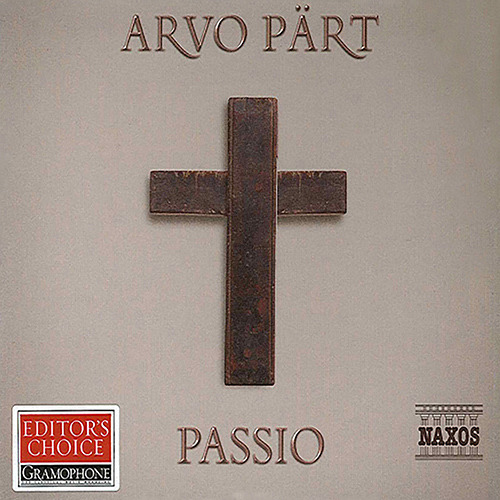PÄRT, A.: Passio Domini nostri Jesu Christi secundum Joannem (St. John Passion) (Tonus Peregrinus, Pitts)
Born near Tallinn in Estonia in 1935, Arvo Pärt emigrted in 1980 and settled in Berlin. Soon after emigrating, Pärt completed the St John Passion which he based on his newfound tintinnabuli principle that “the melody and the accompaniment is one”. Settings of the Passion are part of a very early tradition in the Church, and in Pärt’s setting it is the text itself which determines the musical structure and even the duration of the silences between the words. Using the most concentrated of means, Pärt communicates the depth and power of the ancient Passion story in a new and compelling way.
Tonus Peregrinus was founded by the composer Antony Pitts in 1990, during his studies with Edward Higginbottom at New College, Oxford, and today is an established ensemble in Britain and abroad with a significant discography. At the core of Tonus Peregrinus are a dozen singers who combine their diverse expertise to interpret a repertoire ranging from the end of the Dark Ages to scores where the ink is still wet; together they have achieved major successes in both new music and early music, including a Cannes Classical Award for the ensemble’s chart-topping début release of Arvo Pärt’s Passio, and The Naxos Book of Carols—circulated to millions of homes in Britain and available as a printed carol-book from Faber Music (www.naxoscarols.com).

Photo courtesy of Ian Dingle

Antony Pitts sang as a treble in the Chapel Royal, Hampton Court Palace; he was an academic scholar and later an honorary senior scholar at New College, Oxford where he founded Tonus Peregrinus. In 2004 their radical interpretation of Arvo Pärt’s Passio (Naxos 8.555860) won a Cannes Classical Award. He has been both a senior producer at BBC Radio 3 and a senior lecturer at the Royal Academy of Music; he is currently a patron of the London Festival of Contemporary Church Music and an honorary Fellow of the Faculty of Church Music. His compositions have been given their premières in Wigmore Hall and Westminster Cathedral in London, the Concertgebouw in Amsterdam, and the Philharmonie Kammermusiksaal in Berlin, and published by Faber Music—notably the 40-part motet XL and The Naxos Book of Carols—and released on Naxos, Hyperion, Harmonia Mundi, Signum, and Unknown Public.

A native of Estonia, Arvo Pärt at first wrote in a style perceptibly influenced by Russian composers. Having then explored the 12-note system through the 1960s, he developed his own tonal technique which he calls ‘tintinnabuli’ (after the bell-like impression of notes in a triad). This technique has been employed in many works since, which are often coloured by the influence of early musical traditions and Pärt’s deep religious feeling.
Orchestral Music
In 1976 Pärt wrote a moving tribute to Benjamin Britten, Cantus in Memory of Benjamin Britten, for string orchestra and bell. His cello concerto Pro et contra and three symphonies reflect the course his music has taken. Tabula Rasa is in the form of a double violin concerto, while Collage über BACH represents an earlier period of his work.
Chamber Music
A wind Quintettino of 1965 was followed in 1977 by the interesting chamber work Fratres (subsequently arranged for various alternative instrumental combinations) and in 1978 by Spiegel im Spiegel (‘Mirror in the Mirror’) for viola and piano (also arranged for cello and piano).
Vocal and Choral Music
Pärt has made a particularly strong impression with works such as his Passio Domini Nostri Jesu Christi secundum Johannem (St John Passion), his Stabat mater for three solo voices and string trio, his Miserere of 1989, and the Biblical Sarah was 90 Years Old. Triodion marked the 150th anniversary of the foundation of Lancing College, and other commissions range from I am the True Vine for Norwich Cathedral to Dopo la vittoria for the 1,600th anniversary of the death of St Ambrose. His Berlin Mass was commissioned for the 90th German Catholic Day and his Magnificat by the German Musikrat.
































